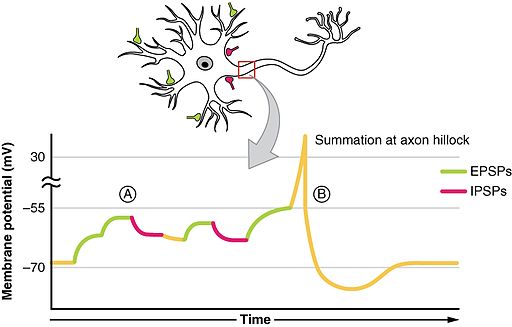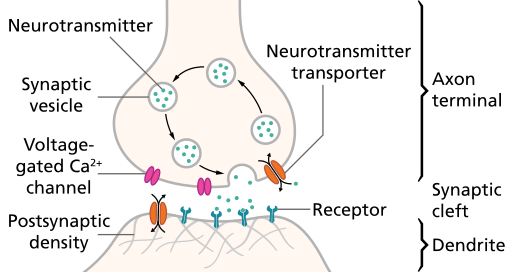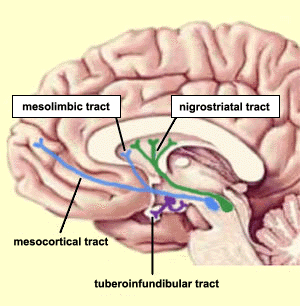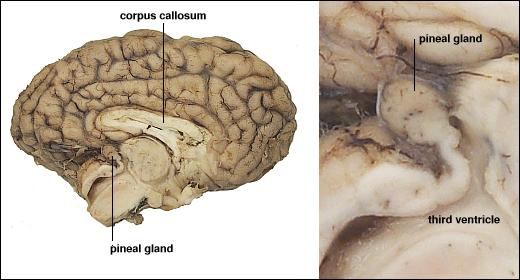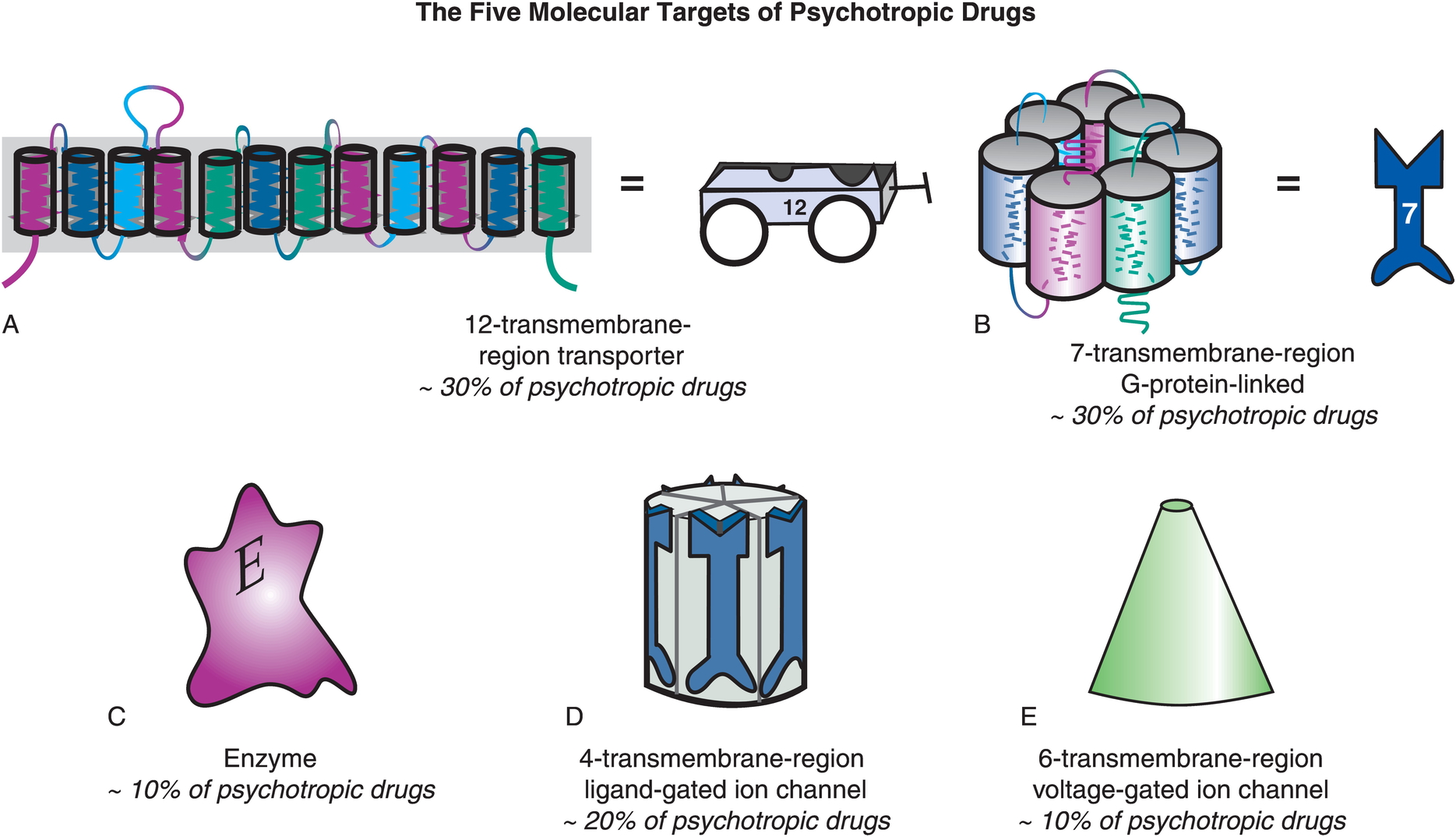Prelude
Today's Topics
- Neurochemistry
- How neurons talk to one another
- Synaptic communication
- Neurotransmitters
In the beginning
- Soma receives input from dendrites
- Axon hillock sums/integrates
- If sum > threshold, AP "fires"
Illustration of summation
Steps in synaptic transmission
- Rapid change in voltage triggers neurotransmitter (NT) release
- Voltage-gated calcium Ca++ channels open
- Ca++ causes synaptic vesicles to bind with presynaptic membrane, merge, exocytosis
Steps in synaptic transmission
- NTs diffuse across synaptic cleft
- NTs bind with receptors on postsynaptic membrane
- Receptors respond
- NTs unbind, are inactivated
Synaptic transmission
Exocytosis
Why do NTs move from presynaptic terminal toward postsynaptic cell?
- Electrostatic force pulls them
- Force of diffusion
Why do NTs move from presynaptic terminal toward postsynaptic cell?
- Electrostatic force pulls them
- Force of diffusion
Postsynaptic receptor types
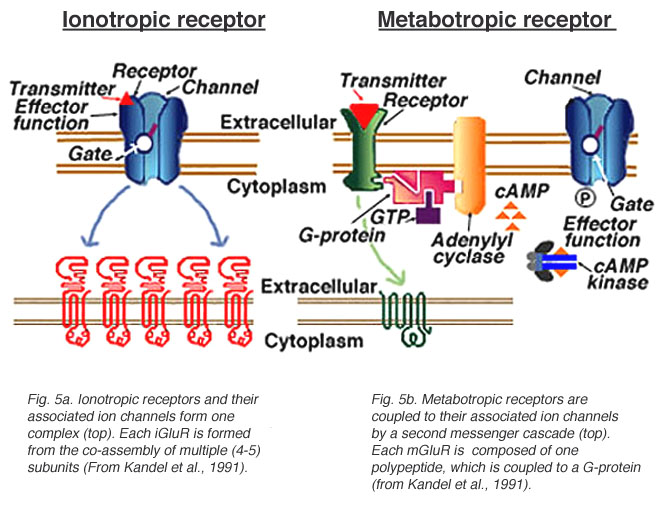
Postsynaptic receptor types
- Ligand-gated ion channels
- Ionotropic (receptor + ion channel)
- Ligand-gated
- Open/close channel
- Faster, but short-acting effects
Postsynaptic receptor types
- Metabotropic (receptor only)
- Trigger 2nd messengers
- G-proteins
- Open/close adjacent channels, change metabolism
- Slower, but longer lasting effects
Receptor types

Receptors generate postsynaptic potentials (PSPs)
- Small voltage changes
- Amplitude scales with # of receptors activated
- Dendrites usually lack voltage gated Na+ channels
- Excitatory PSPs (EPSPs)
- Depolarize neuron (make more +)
- Inhibitory (IPSPs)
- Hyperpolarize neuron (make more -)
NTs inactivated
- Buffering
- e.g., glutamate into astrocytes (Anderson & Swanson, 2000)
- Reuptake via transporters
- molecules in membrane that move NTs inside
- e.g., serotonin via serotonin transporter (SERT)
- Enzymatic degradation
- e.g., acetylcholinesterase (AChE) degrades acetylcholine (ACh)
Questions to ponder
- Why must NTs be inactivated?
Questions to ponder
- Why must NTs be inactivated?
- Keeps messages discrete, localized in time and space
- Maximizes concentration gradient
What sort of PSP would opening a Na+ channel produce?
- Excitatory PSP, Na+ flows in
- Excitatory PSP, Na+ flows out
- Inhibitory PSP, Na+ flows in
- Inhibitory PSP, Na+ flows out
What sort of PSP would opening a Na+ channel produce?
- Excitatory PSP, Na+ flows in
- Excitatory PSP, Na+ flows out
- Inhibitory PSP, Na+ flows in
- Inhibitory PSP, Na+ flows out
What sort of PSP would opening a Cl- channel produce?
Remember [Cl-out]>>[Cl-in]
- Excitatory PSP, Cl- flows in
- Excitatory PSP, Cl- flows out
- Inhibitory PSP, Cl- flows in
- Inhibitory PSP, Cl- flows out
What sort of PSP would opening a Cl- channel produce?
Remember [Cl-out]>>[Cl-in]
- Excitatory PSP, Cl- flows in
- Excitatory PSP, Cl- flows out
- Inhibitory PSP, Cl- flows in
- Inhibitory PSP, Cl- flows out
Types of synapses
Synapses on
- dendrites
- usually excitatory
- cell bodies
- usually inhibitory
- axons
- usually modulatory (change p(fire))
Summary of chemical transmission

Neurotransmiters
| Family | Neurotansmitter |
|---|---|
| Amino acids | Glutamate |
| \(\gamma\) aminobutyric acid (GABA) | |
| Glycine | |
| Aspartate |
Glutamate
- Primary excitatory NT in CNS
- Role in learning (via NMDA)
- Receptors on neurons and glia (astrocytes and oligodendrocytes)
- Linked to umami (savory) taste sensation (think monosodium glutamate or MSG)
- Dysregulation in schizophrenia? (Javitt, 2010)
Glutamate
| Type | Receptor | Esp Permeable to |
|---|---|---|
| Ionotropic | AMPA | Na+, K+ |
| Kainate | ||
| NMDA | Ca+ | |
| Metabotropic | mGlu |
\(\gamma\) aminobutyric acid (GABA)
- Primary inhibitory NT in CNS
- Excitatory in developing CNS, [Cl-] in >> [Cl-] out
- Binding sites for benzodiazepines (e.g., Valium), barbiturates, ethanol, etc.
| Type | Receptor | Esp Permeable to |
|---|---|---|
| Ionotropic | GABA-A | Cl- |
| Metabotropic | GABA-B | K+ |
GABA

"GABAA-receptor-protein-example" by Chemgirl131 at English Wikipedia - Transferred from
en.wikipedia to Commons by Sreejithk2000 using CommonsHelper.. Licensed under Public Domain via Commons.
Other amino acid NTs
- Aspartate
- Like Glu, stimulates NMDA receptor
- Glycine
- Spinal cord interneurons
Acetylcholine (ACh)
- Primary excitatory NT of CNS output
- Somatic nervous system (motor neuron -> neuromuscular junction)
- Autonomic nervous system
- Sympathetic branch: preganglionic neuron
- Parasympathetic branch: pre/postganglionic
ACh anatomy
Acetylcholine
| Type | Receptor | Esp Permeable to | Blocked by |
|---|---|---|---|
| Ionotropic | Nicotinic (nAChR) | Na+, K+ | e.g., Curare |
| Metabotropic | Muscarinic (mAChR) | K+ | e.g., Atropine |
Curare

Atropine
- aka, nightshade or belladonna
Monoamine NTs
| Family | Neurotansmitter |
|---|---|
| Monoamines | Dopamine (DA) |
| Norepinephrine (NE)/Noradrenaline (NAd) | |
| Epinephrine (Epi)/Adrenaline (Ad) | |
| Serotonin (5-HT) | |
| Melatonin | |
| Histamine |
Information processing
- Point-to-point
- One sender, small number of recipients
- Glu, GABA
- Broadcast
- One sender, widespread recipients
- DA, NE, 5-HT, melatonin, histamine
- Need to know
- NT, where projecting, type of receptor to predict function
Dopamine
- Released by
- Substantia nigra -> striatum, meso-striatal projection
- Ventral tegmental area (VTA) -> nucleus accumbens, ventral striatum, hippocampus, amygdala, cortex; meso-limbo-cortical projection
Dopamine Anatomy
DA Disruption linked to
- Parkinson's Disease (mesostriatal)
- DA agonists treat (agonists facilitate/increase transmission)
- ADHD (mesolimbocortical)
- Schizophrenia (mesolimbocortical)
- DA antagonists treat
- Addiction (mesolimbocortical)
DA Inactivated by
- Dopamine transporter (DAT) and chemical breakdown
http://www.scholarpedia.org/article/Dopamine_anatomy#Dopamine_receptors
Dopamine receptors
| Type | Receptor | Comments |
|---|---|---|
| Metabotropic | D1-like (D1 and D5) | more prevalent |
| D2-like (D2, D3, D4) | target of many antipsychotics |
Norepinephrine
- Released by
- locus coeruleus in pons
- postganglionic sympathetic neurons onto target tissues
- Role in arousal, mood, eating, sexual behavior
- Monoamine oxidase inhibitors (MAOIs)
- inactivate monoamines in neurons, astrocytes
- MAOIs increase NE, DA
- Treatment for depression
NE Anatomy
NE receptors
| Type | Receptor | Comments |
|---|---|---|
| Metabotropic | \(\alpha\) (1,2) | antagonists treat anxiety, panic |
| \(\beta\) (1,2,3) | 'beta blockers' in cardiac disease |
Serotonin (5-HT)
- Released by raphe nuclei in brainstem
- Role in mood, sleep, eating, pain, nausea, cognition, memory
- Modulates release of other NTs
- Most of body's 5-HT regulates digestion
5-HT anatomy
Separate cortical, subcortical 5-HT projection pathways?
5-HT receptors
- Seven families (5-HT 1-7) with 14 types
- All but one metabotropic
5-HT clinical significance
- Ecstasy (MDMA) disturbs serotonin
- So does LSD
- Fluoxetine (Prozac)
- Selective Serotonin Reuptake Inhibitor (SSRI)
- Treats depression, panic, eating disorders, others
- 5-HT3 receptor antagonists are anti-mimetics used in treating nausea
Melatonin
- Released by pineal gland
Histamine
- Released by hypothalamus, projects to whole brain
- \(H_1\)-\(H_4\) Metabotropic receptors, one ionotropic type in thal/hypothal
- Role in arousal/sleep regulation
- In body, part of immune/inflammatory response
Targets of psychotropic drugs
Monoamine Song
Monoamine Song
Monoamines, do-do do do-do Monoamines, do do do-do Monoamines, do do do do-do do do-do do do-do do do do do-do do
Monoamine Song
Monoamines, do-pa-mine is one Monoamines, norepi, too Monoamines, sero-tonin e-pinephrine, dop-a- mine, nor-epinephrine, melatonin, whoo!
Monoamine Song
Monoamines, mod-u-late neurons Monoamines, throughout the brain Monoamines, keep people happy, brains snappy, not sleepy, not sappy, do-do do-do do-do do
Others
- Gases
- Nitric Oxide (NO), carbon monoxide (CO)
- Neuropeptides
- Substance P and endorphins (endogenous morphine-like compounds) have role in pain
- Orexin/hypocretin, project from lateral hypothalamus across brain, regulates appetite, arousal
- Cholecystokinin (CCK) stimulates digestion
- Purines
- Adenosine (inhibited by caffeine)
- Others
- Anandamide (activates endogenous cannabinoid receptors)
References
Anderson, C. M., & Swanson, R. A. (2000). Astrocyte glutamate transport: Review of properties, regulation, and physiological functions. Glia, 32(1), 1–14. https://doi.org/10.1002/1098-1136(200010)32:1<1::AID-GLIA10>3.0.CO;2-W
Javitt, D. C. (2010). Glutamatergic theories of schizophrenia. Israel Journal of Psychiatry and Related Sciences, 47(1), 4.
Ren, J., Friedmann, D., Xiong, J., Liu, C. D., Ferguson, B. R., Weerakkody, T., … Luo, L. (2018). Anatomically defined and functionally distinct dorsal raphe serotonin sub-systems. Cell. https://doi.org/10.1016/j.cell.2018.07.043
